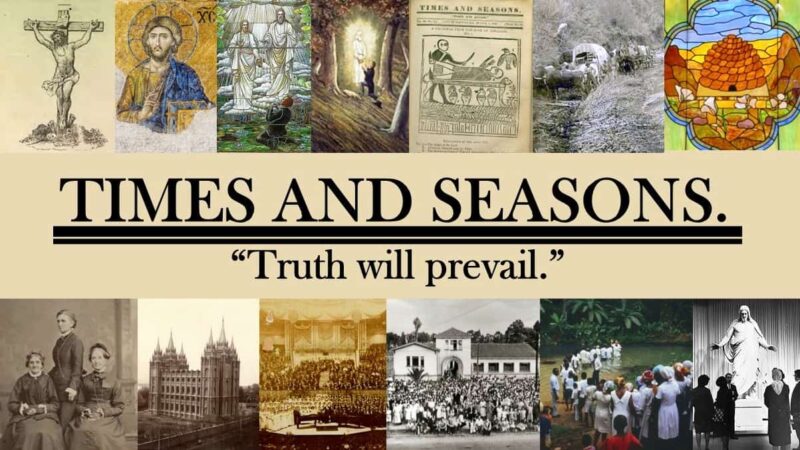The 1856 handcart tragedy remains a defining, painful moment in Latter-day Saint history, and the question of “who is responsible?” has echoed for generations. We often settle for simple answers or familiar myths. However, a recent interview at the Latter-day Saint history blog, From the Desk, with Don H. Smith and Mark C. Austin, authors of Bring Them to Zion, challenges these easy narratives. Their analysis argues that the disaster cannot be blamed on any single individual. Instead, the tragedy was a catastrophic, complex failure: a perfect storm of flawed instructions from Brigham Young, critical missteps by leaders in the field, and a fatal breakdown in communication that stopped supply trains from reaching the pioneers. This discussion moves us beyond a simple search for a scapegoat and forces a more mature engagement with the full, complicated history, demanding we honor the pioneers’ sacrifice by understanding the complete story.
One point to keep in mind while discussing the tragedy of the Willie and Martin handcart companies is that handcarts were only a temporary experiment in the saga of Latter-day Saint emigration. I’ve discussed this in one of my most-visited posts of all time (Handcarts and History), but it’s a point that comes up in the interview as well:
Handcarts were introduced in 1856 as an effort to keep expenses down while simultaneously maximizing the number of poor, faithful saints who could come to Zion. At the time, there were more Latter-day Saint members in Europe than in the United States, and many were poverty-stricken. Others were subjected to persecution because of their beliefs and needed relief. Furthermore, the Church was in debt over $60k from the 1855 emigration.
Brigham Young chose to give the poor Saints in Europe access to the Perpetual Emigrating Fund. Some of the early English converts had been Church members for fifteen to eighteen years, and Young thought it was time to bring these people from England to Utah.
Handcarts were only used for a couple of years, about ten years after the Latter-day Saint emigration to the Intermountain West began. The majority of the handcart companies were a relatively successful (if gruelling) approach to overland migration.
Still, the Martin and Willie handcart companies faced a series of difficulties that caused delays. As Don H. Smith and Mark C. Austin summarized:
This is a short breakdown of the most important factors that led to the late departure of the 1856 handcart companies:
- Liverpool Delays — The companies faced setbacks in leaving Liverpool because of late instructions, limited ships, and insufficient funds.
- PEF Funding Sources — The 1856 emigrants were supported by the Perpetual Emigrating Fund, which relied on donations and Church resources.
- Liverpool Planning Meeting — Leaders held a planning meeting in Liverpool to determine how many pioneers could be sent that season.
- Expense Pressures — Leaders felt heavy pressure to minimize costs at every stage of the migration effort.
- Handcart Challenges — The decision to use handcarts introduced a new and largely untested method of travel.
- Iowa City Shortages — Upon their arrival in Iowa City, the emigrants found that the handcarts were not yet ready for use.
- Craftsmen-Built Carts — Local pioneer craftsmen were enlisted to build the handcarts, though their workmanship and available materials created problems.
- Green Wood Problems — Many carts were built with green wood, which warped and broke under the strain of the journey.
- Florence Decision Point — Leaders wrestled with whether to stop at Florence, Nebraska, for the winter or to continue the trek west.
On the final point, the Latter-day Saint film 17 Miracles depicts the discussion at Florence from Levi Savage’s viewpoint, leading viewers to sympathize with his perspective and suggestion to overwinter in Nebraska. In the interview, however, it is pointed out that “Levi Savage, though a veteran of the Mormon Battalion, had neither wintered in the Florence area nor traveled the Mormon Trail west. In that sense, he was as unfamiliar with the region as many of the emigrants.” In contrast, “James G. Willie had traveled the trail twice and had spent a winter in Florence. Local outfitters also understood the risks of stopping there in ways that Savage did not.” The decision wasn’t between two good options or a good option and a bad option. The decision to move forward was a calculated risk that leaders of the company hoped was the least bad option when no good options were available:
Delays had begun in England and continued throughout the journey, and once the emigrants were in motion, stopping was not a simple option.
Most Saints had already sold their homes, left their jobs, and disposed of their furniture in Europe. Unlike the Winter Quarters experience of 1846, the handcart companies in 1856 lacked the supplies to last through the winter, as well as the tools needed to build housing.
By then, all the land around Florence was privately owned, leaving no free space for building or camping, and there was no accessible supply of wood for construction or fuel.
In short, the situation in 1856 was very different from 1846—and the available choices were both complex and costly.
While Savage has been hailed for accurately predicting the problems that would arise, there would have been serious problems with staying in Nebraska as well.
There’s much more in the interview with Don H. Smith and Mark C. Austin on the Willie and Martin Handcart companies – it’s a rich, historical discussion that’s worth the time to read. While there, check out the new D. Todd Christofferson quotes page, honoring his call to the First Presidency.

Comments
One response to “The Handcart Tragedy”
I did not know that. Thank you.